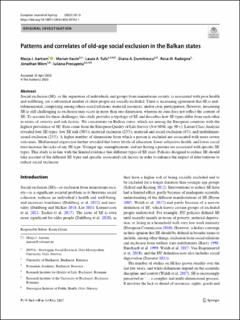| dc.description.abstract | Social exclusion (SE), or the separation of individuals and groups from mainstream society, is associated with poor health and wellbeing, yet a substantial number of older people are socially excluded. There is increasing agreement that SE is multidimensional, comprising among others social relations, material resources, and/or civic participation. However, measuring SE is still challenging as exclusion may occur in more than one dimension, whereas its sum does not reflect the content of SE. To account for these challenges, this study provides a typology of SE and describes how SE types differ from each other in terms of severity and risk factors. We concentrate on Balkan states, which are among the European countries with the highest prevalence of SE. Data come from the European Quality of Life Survey (N = 3030, age 50 +). Latent Class Analysis revealed four SE types: low SE risk (50%), material exclusion (23%), material and social exclusion (4%), and multidimensional exclusion (23%). A higher number of dimensions from which a person is excluded are associated with more severe outcomes. Multinomial regression further revealed that lower levels of education, lower subjective health, and lower social trust increase the risks of any SE type. Younger age, unemployment, and not having a partner are associated with specific SE types. This study is in line with the limited evidence that different types of SE exist. Policies designed to reduce SE should take account of the different SE types and specific associated risk factors in order to enhance the impact of interventions to reduce social exclusion. | en_US |

